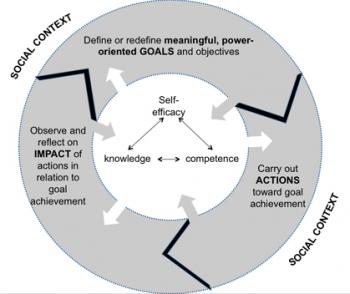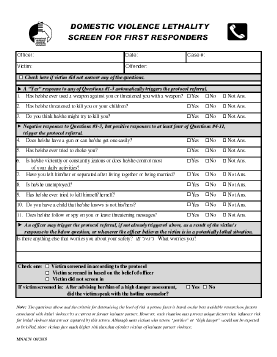While lethality assessment and risk assessment are overlapping concepts, they do not measure the same thing. The main difference is whether a tool was designed to measure 1) the risk of reoffense/reassault (the likelihood that abuse will occur again, often measured after corrective action has been taken, a.k.a, “recidivism”) or 2) the risk of homicide (the likelihood that a fatality will result). After the general resources provided below, you will find materials related to six leading assessment tools. Each tool includes a notation about the field of intended use, the perspective being evaluated, and an indication of whether the tool assesses reoffense/reassault or lethality risk.
 The Empowerment Process Model illustrated here (Bennett Cattaneo & Chapman, 2010) provides a helpful framework for engaging in risk assessment that shifts the focus from prediction to management. Lauren Bennett Cattaneo (2011) suggests that instead of asking, "What are the chances violence will occur?" we should instead ask, "Under what circumstances might violence occur, and how might we change them?" Effective risk assessment practices need to pull prediction into management, give victim voice, and integrate advocate expertise.
The Empowerment Process Model illustrated here (Bennett Cattaneo & Chapman, 2010) provides a helpful framework for engaging in risk assessment that shifts the focus from prediction to management. Lauren Bennett Cattaneo (2011) suggests that instead of asking, "What are the chances violence will occur?" we should instead ask, "Under what circumstances might violence occur, and how might we change them?" Effective risk assessment practices need to pull prediction into management, give victim voice, and integrate advocate expertise.
 Integrating Risk Assessment in a Coordinated Community Response from the Battered Women's Justice Project explores the benefits of utilizing risk assessments and reviews the various available tools. It offers considerations and resources to support CCR teams engaging in this process.
Integrating Risk Assessment in a Coordinated Community Response from the Battered Women's Justice Project explores the benefits of utilizing risk assessments and reviews the various available tools. It offers considerations and resources to support CCR teams engaging in this process.
Perspective: victim
Assesses: lethality risk and reassault
 Domestic Violence Lethality Screen for First Responders
Domestic Violence Lethality Screen for First Responders
In 2003, the Maryland Network Against Domestic Violence established a statewide Lethality Assessment Committee. This committee developed an assessment instrument called the Lethality Screen for First Responders(plus a protocol) using the Danger Assessment as a guide (see page 5). The instrument is currently being used by law enforcement in all Maryland counties. When victims (in an intimate partner relationship) screen in on the Lethality Screen as being in High Danger, the officer on the scene calls a domestic violence hotline and encourages the victim to speak with the hotline counselor. If a victim seeks services from a domestic violence program, in addition to normal intake procedures, a program counselor will conduct Dr. Campbell’s Danger Assessment, and the program will provide a range of enhanced services that consider the victim's assessed situation
Perspective: offender
Assesses: reoffense/reassault
Perspective: victim
Assesses: lethality risk
Perspective: offender
Assesses: reoffense/reassault
Perspective: offender
Assesses: reoffense/reasasult
Perspective: victim
Assesses: lethality risk









